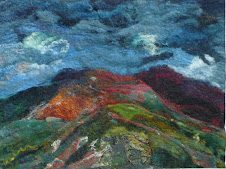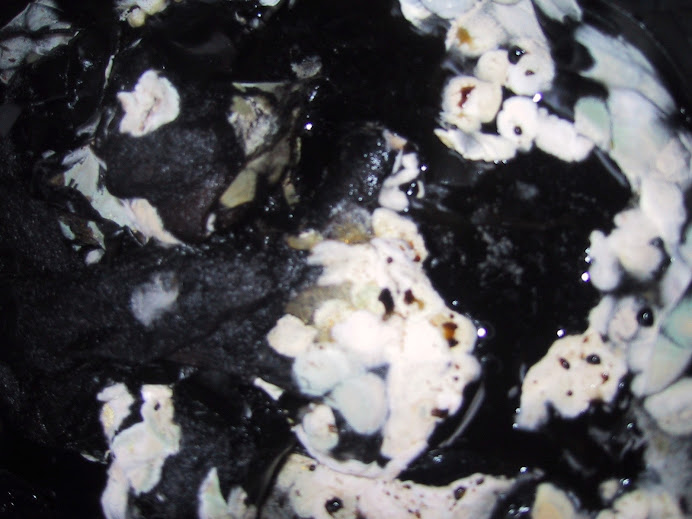 Posted by Helen
Posted by Helen We have a number of additions to the Dye Garden lately, Asclepius Tuberosa or Butterfly milkweed is the latest and the one of which Enys is most proud as she has nurtured it and overwintered it and here it is in flower. This plant is a member of the Asclepiadaceae or milkweed family although it does not have a milky sap. It is a native of North America found in sandy loamy or calcerous soils of prairies and open woods and is a dye plant producing a range of yellows golds and light bright olives depending on mordant but we are also interested in it as it attracts butterflies which fill our other criteria forthe garden -that it is a garden for the wildlife. It was also used by Native Americans and early settlers for the treatmentof lung complaints-so defintely a good one for me to have- and it was at one time called pleurisy root. It was also used as analgesic, laxative, dermatological and gynacological aid
All this information about it comes from Dyes from American Native Plants A Practical Guide by Lynne Richards and Ronald J Tyrl published by Timber Press Inc ISBN 0-88192-688-X , which Enys brought back from the US a couple of years ago.
Dye Plants in Flower at the moment also include: Viper Bugloss in the picture below, supposed to give purple with roots-yet another one Imust try!
 Iris Pseudocorus supposed to give black with the root but not by me
Iris Pseudocorus supposed to give black with the root but not by me
Cosmos Sulphureus flowers give yellows

Weld Reseda Luteola-this year we have had a a lotof weld but it is all self seeded and this large plant was at the edge of a a bed dug at the beginning of the growing season last year -it set a florette last year and this year has just grown and grown.This of course gives a bright lightfast acid yellow which with ammonia is almost florescent
 Here is our u shaped foxglove it had fallen over got propped up again and this is the result.
Here is our u shaped foxglove it had fallen over got propped up again and this is the result. and finally -the principal reason why Enys put mullein Verbascum Thapsus in the garden -it is the only place for the mullein moth, Cucullia verbasci, and here are the happy caterpillars
and finally -the principal reason why Enys put mullein Verbascum Thapsus in the garden -it is the only place for the mullein moth, Cucullia verbasci, and here are the happy caterpillars Jill Goodwin in a Dyers Manual says with copper sulphate this gives a good green but it is one of those plants I have yet to get round to trying.
Jill Goodwin in a Dyers Manual says with copper sulphate this gives a good green but it is one of those plants I have yet to get round to trying.



























The Asclepius tuberosa is very attractive, also the Cosmos sulphureus.
ReplyDeleteI hadn't thought of Weld as a particularly attractive plant, until one of my neighbours who is a keen gardener came around and saw it in full flower, she thought it was stunning, and when I thought about it I had to agree, but of course I'd planted it for the dye pot ;)
What intrigues me is that people are astonished to find that Weld grows around here saying in a puzzled voice "I have never heard of it" but there used to be stands on it growing on rough ground till they built houses on it. And it did look dramatic! I can't imagine dyeing with the butterfly weed it looks too pretty.
ReplyDeleteMilkweed sounds like it would be used for something to do with milk, i.e. ingesting to bring forth milk to feed a baby or maybe because it has a milky looking sap. Isn't it amazing how our ancestors have found a purpose for all these wonderful plants?
ReplyDeleteBlessings, Star
lucky you - I tried several of the asclepias species a few years back, but it didn't work. they germinated and grew on for a while, but I didn't manage to overwinter them, not even in the tunnel:(( I didn't want them for their dye properties though - I wanted them for their seed fibres, because I wanted to try to spin them:)) and apparently you can use stem fibres of some of them as well! interesting plants for further tests! btw, have you tried to dye with eupatorium purpureum?
ReplyDeleteHi Bettina I haven't.Nor do any of my dye books mention it as a dye,the nearest is the North American Dye book which mentions a relation E.Rugosum which is also poisonous . So tell me what colour do you get from it?
ReplyDeleteThe aesclepis T is looking very happy at the moment -perhaps I have a slightly milder climate here- so if it produces seeds I will send you some to spin with. Enys grew three of which I have one so between all three we might have enough for you to spin a sample.
Helen, I think I am going to try again right after flowering this time! I read that the seed heads make a pinkish to red tone, but when I used the very dry flowerheads last year I only managed a slightly "dirty" beige. maybe they should be used fresh - I'll give it a try. though the plant is nice to look at even without dye properties:) and the butterflies and bees adore the flowers!
ReplyDeletethanks for the idea with the seeds, that would be lovely.
What a wonderful tour. Now that I finally have a place to put it, a dye garden is on my project list!
ReplyDeleteEupatorium purpureum-Joe Pye Weed.
ReplyDeleteBettina I asked Enys who immediately said it was a dye plant in some of her books, although she is not sure which one or indeed what colour. She had planted it although she had regretted it as it was a garden thug. Then I saw a reference t o it today where it was said to give yellows with alum and green with copper sulphate.
bw Helen